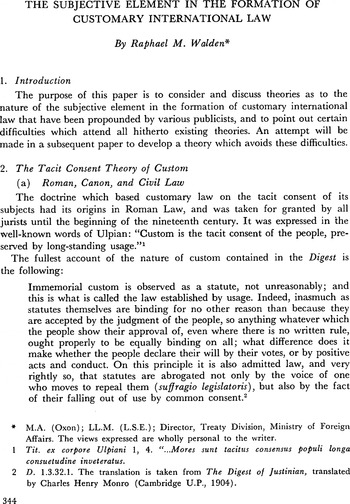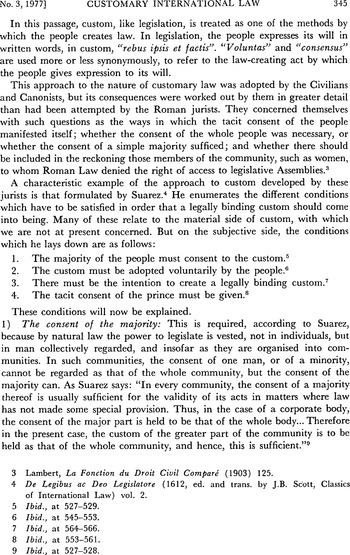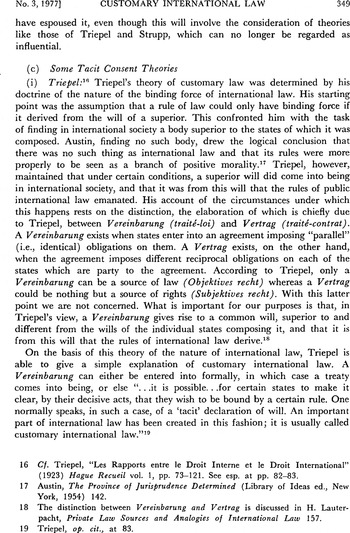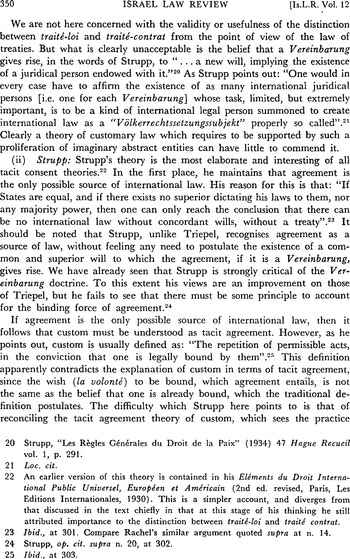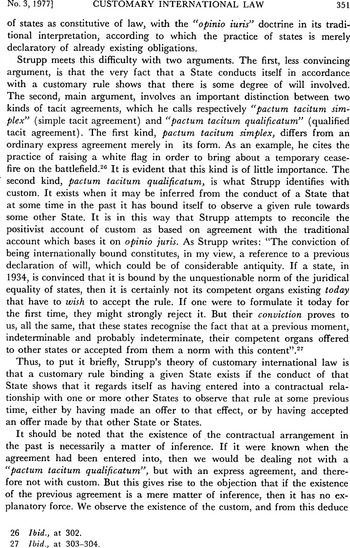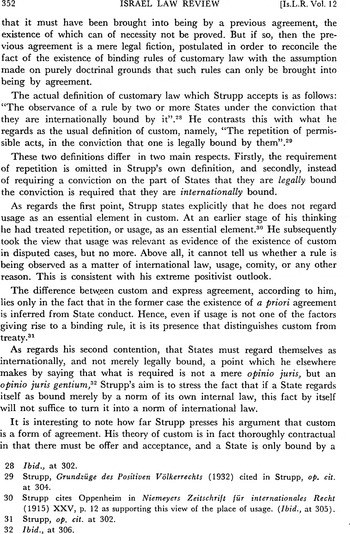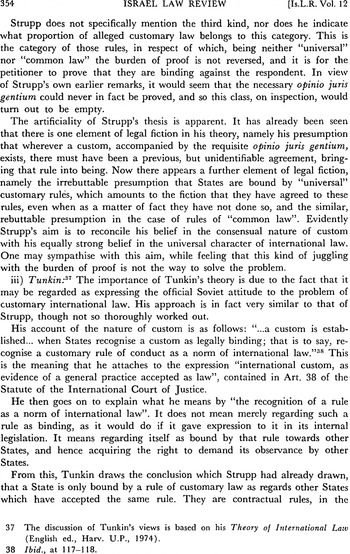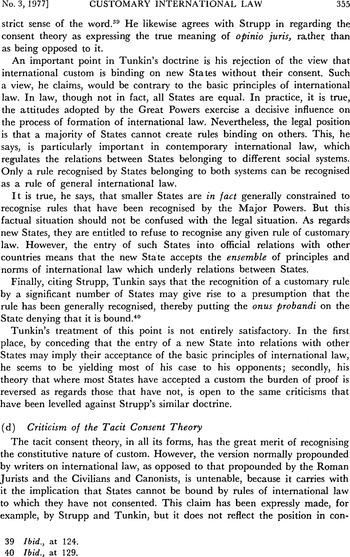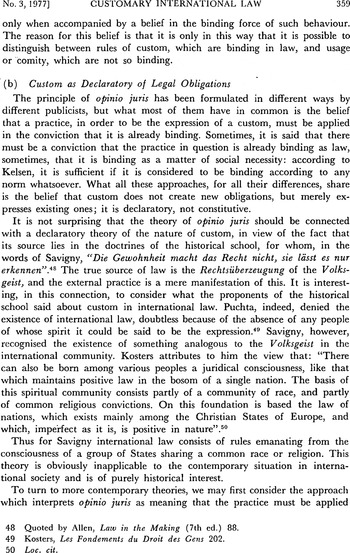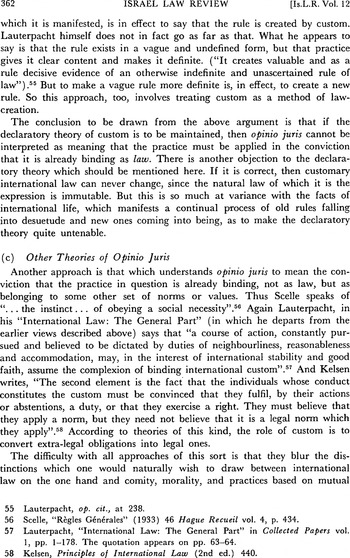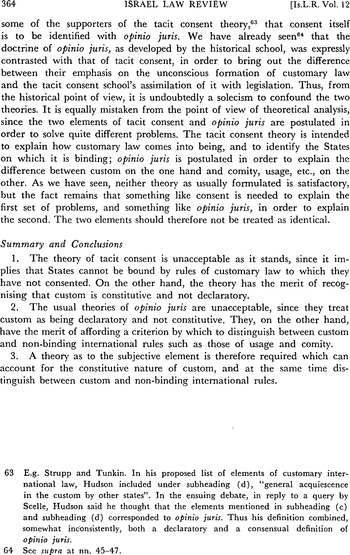1. Introduction
The reprinting of Raphael Walden's article, ‘The Subjective Element in the Formation of Customary International Law’,Footnote 1 forty years after its first publication, is a timely opportunity to examine briefly the current health of some of the long-standing theoretical controversies associated with customary international law, including opinio juris. For decades, these have provided scholars with a fertile research agenda, so much so that customary international law has been depicted as no less than ‘a riddle inside a mystery wrapped in an enigma’;Footnote 2 but such controversies have also proven to be, well, theoretical. They have not stood in the way of courts, practitioners and writers in regularly identifying and applying customary international law: the academic torment that accompanied this source of law in the books has not impeded it in action.Footnote 3 Such accumulated practice, for its part, has clarified much about the operation of customary international law and supplied both authors and practitioners with insights into, and indeed answers to several of the difficulties. As a result, customary international law today is not only as present in the international legal system as it has always been; it is perhaps also better understood than before.
2. The Subjective Element
Let us begin by looking at opinio juris, the subjective element of customary international law that Thirlway so memorably described as the ‘philosopher's stone which transmutes the inert mass of accumulated usage into the gold of binding legal rules’.Footnote 4 In taking on this subject, Walden joined a fascinating conversation spanning centuries of legal thought: the ‘extra ingredient’ necessary to transform a general practice into a binding rule, as Kadens and Young have argued, ‘has always been the central problem’ in theorising customary (international) law.Footnote 5 Walden grappled with the writings of such jurists as Ulpian and Suarez, Grotius and Vattel, as well as Tunkin, Kelsen and Lauterpacht, in identifying and dissecting two central theories that have previously been put forward to explain the nature of the subjective element. The first, that of tacit consent, he found to have the merit of recognising custom as law-creative (as opposed to strictly declarative of pre-existing law) but ultimately defective in implying that states cannot be bound by customary rules to which they have not agreed. He appreciated the second theory, or rather theories, based on the classical doctrine of opinio juris, as providing a criterion for distinguishing between customary international law and mere usage; but he rejected it, too, because it treated custom as merely declarative and not also constitutive of rules of law.Footnote 6 Writing as a practitioner informed by, inter alia, the development of the customary international law of the continental shelf and the recognised potential role of United Nations (UN) resolutions in the customary process,Footnote 7 Walden then proposed, in a companion paper published in the Israel Law Review in 1978, his own approach to the subjective element of customary international law.Footnote 8 Borrowing from HLA Hart's theory of the ‘internal aspect’ of rules (and following in Thirlway's footsteps), he there suggested that the troubled concept of opinio juris should be reformulated to acknowledge that the subjective element accompanying the relevant practice ‘may be, not a belief that the practice is already legally binding, but a claim that it ought to be legally binding’.Footnote 9 By this he tackled head-on the so-called ‘opinio juris paradox’ that authors have described ‘in loving detail’;Footnote 10 held opinio juris to be an observable fact rather than an indiscernible inner feeling; and, ultimately, treated the enigmatic Latin phraseFootnote 11 as just another juridical term in the service of mediating between real-world facts and the law.
Such an approach does appear to correspond with the development of much of contemporary customary international law, and is compatible with the wording of the almost century-old formula in the Statute of the International Court of Justice (ICJ Statute), which refers to international custom as a general practice that is ‘accepted as law’.Footnote 12 It also makes it possible to take account of early practice in assessing the requirement of generality, as ‘has undoubtedly been the practice of international tribunals faced with problems of the existence or non-existence of rules of customary law’.Footnote 13 Furthermore, this approach is in line with the current work of the International Law Commission (ILC) under the heading ‘Identification of Customary International Law’. While the ILC has been able to avoid some of the theoretical debates connected with the formation of customary international law given its focus on identification, it has recognised that in practice the two cannot always be considered in isolation and partly for that reason has opted to refer to the subjective element primarily by the term ‘accepted as law’ in the ICJ Statute (with opinio juris retained in parentheses, given its prevalence in legal discourse).Footnote 14 The Commission has also offered a non-exhaustive list of potential forms of evidence of acceptance as law, having surveyed numerous decisions that have once again illustrated that establishing opinio juris has not ‘present[ed] as much difficulty as the writers have anticipated’.Footnote 15 The list refers to public statements made on behalf of states, official publications, government legal opinions, diplomatic correspondence, decisions of national courts, treaty provisions, conduct in connection with resolutions adopted by an international organisation or at an intergovernmental conference, and inaction (under certain circumstances).Footnote 16 Guidance has also been provided on how to distinguish between acceptance as law and other motives that may accompany a certain practice.Footnote 17 All of this suggests that the subjective element is not (or is perhaps no longer) an elusive, intangible notion in dire need of deciphering.
3. The Objective Element
The element of practice, which ‘both defines and limits’ customary international law,Footnote 18 has not been free of controversy either. The role that verbal acts play in the formation of customary rules, in particular, once sharply divided those who thought it ‘legally unacceptable to exclude communications, written and spoken words, from the world of State practice’,Footnote 19 and those who considered that ‘a State has not done anything when it [merely] makes a claim’.Footnote 20 The former have clearly had the upper hand: it is widely accepted today that practice may take a wide range of forms, including both physical and verbal acts (and, under certain circumstances, inaction).Footnote 21 Such an approach, which finds much support in judicial practice, recognises that states exercise their powers in various ways and do not confine themselves only to some types of act. The alternative is too restrictive, especially as action may at times consist solely in statements (for example, a protest by one state addressed to another) and because accepting such a view may be seen as encouraging confrontation and even the use of force.Footnote 22
Writers have also been divided on the question of whether practice may be relevant for the purposes of customary international law only when it relates to a situation at the international level and to some actual incident of making a claim (as opposed to assertions in abstracto).Footnote 23 However, such positions seem by now to have been abandoned. The development of international human rights law, for example, has illustrated that conduct within the state (such as a state's treatment of its own nationals) may also be relevant to international law, and that it may very well be that ‘the materials not related to sudden crises are more likely to represent a mature and consistent view of the law’.Footnote 24 It is no longer seriously contested, moreover, that relevant practice may emanate from any organ of the state, and not only from those authorised to represent the state in its international relations.Footnote 25
The length of time required for the formation of a rule of customary international law has also been the subject of disagreement. Some, attached perhaps to a conception of custom in domestic societies (or, perhaps, to an outmoded view of customary international law), have argued that ‘[c]ertainly practice over a more or less long period is an essential ingredient of customary law’.Footnote 26 The jurisprudence of the ICJ, however, has clarified that there is no specific requirement with regard to how long a practice must exist before it can ripen into a rule of customary international law. In the oft-cited words of the North Sea Continental Shelf judgment, ‘the passage of only a short period of time is not necessarily, or of itself, a bar to the formation of a new rule of customary international law’ where a general practice that is accepted as law may be observed.Footnote 27 On the other hand, it is equally clear by now that, despite continuing academic fascination with the term,Footnote 28 there is no such thing as ‘instant custom’.Footnote 29
Another dispute that belongs in the past concerns the extent of consistency that ought to be observed before a certain practice may be said to be general. It is widely held that absolute uniformity is not required, and that some inconsistencies and contradictions are not necessarily fatal to a finding of ‘a general practice’. Here, too, the case law of the ICJ and of other courts and tribunals, and the work of authors and of bodies such as the International Law Association and the ILC, have provided useful guidance, including on how variations in the relevant practice are to be assessed.Footnote 30
There is also general agreement with respect to the proposition that the acts of entities other than states (and in some circumstances intergovernmental organisations) – such as non-governmental organisations, non-state armed groups, transnational corporations and private individuals – do not count for the formation or identification of customary rules (but may have an important indirect role).Footnote 31 Official statements and publications of the International Committee of the Red Cross (ICRC), for example, may serve as helpful records of relevant practice (and acceptance as law) and play an important role in shaping the practice of states, but they are not practice that itself gives rise to or reflects customary international law.Footnote 32
4. The Significance of the Two Constituent Elements
Controversy has also surrounded the very need for the two constituent elements in the formation and identification of customary international law. Several writers, in particular, have argued that customary rules need not all be pressed into ‘the Procrustean bed of traditional practice and opinio iuris’.Footnote 33 Some have argued that widespread and consistent state practice may alone suffice for constructing customary international law,Footnote 34 while others, straying even further from the standard notion of customary law, were willing to relax the practice requirement to a vanishing point and concentrate instead on opinio juris.Footnote 35 As advocates of ‘modern’ custom, the latter have sought to turn the ascertainment of customary rules into a normative exercise rather than an empirical one, ‘attach[ing] greater relative weight to what ought to be than to what is’,Footnote 36 particularly in the fields of international humanitarian law, human rights law and environmental law.
However, the conceptual stretching espoused by single-element approaches results in a distortion or even a denial of customary international law, and risks severely undermining its stability and legitimacy. As Wolfke explained:Footnote 37
Without practice (consuetudo), customary international law would obviously be a misnomer, since practice constitutes precisely the main differentia specifica of that kind of international law. On the other hand, without the subjective element of acceptance of the practice as law the difference between international custom and simple regularity of conduct (usus) or other non-legal rules of conduct would disappear.
In any event, such a ‘veritable revolution in the theory of custom’Footnote 38 has gained no traction with states and no significant following among practitioners. The ICJ ‘has repeatedly laid down … [that] the existence of a rule of customary international law requires that there be “a settled practice” together with opinio juris’.Footnote 39 The ILC, too, has recently confirmed that, in all fields of international law, ‘t[o] determine the existence and content of a rule of customary international law, it is necessary to ascertain whether there is a general practice that is accepted as law (opinio juris)’.Footnote 40 Such authoritative determinations, and even more so their reception by states, have made it clear that alternative approaches to the formation and identification of customary international law are, essentially, policy proposals. As such they may be instructive, but they remain policy, not law.Footnote 41
5. The Role of UN General Assembly Resolutions
Another theoretical controversy that seems to have been largely put to rest concerns the ability of resolutions adopted by a body composed of states, in particular the UN General Assembly, to create, simply by their adoption, rules of customary international law. That such resolutions may sometimes have a significant role as evidence of, or impetus for customary international law is widely accepted. Some, however, have taken this potential ‘normative value’Footnote 42 of resolutions to mean that, albeit very exceptionally, they are capable of giving rise to customary international law by the mere fact of their adoption.Footnote 43 Such a position runs counter to the terms of the UN Charter,Footnote 44 which does not provide the General Assembly with any such power, and to the basic two-element approach, which requires not only a sense of a legal right or obligation but also a general practice embodying it. In Tomka's words:Footnote 45
The resolution does not have any legal force of its own, and it must be considered whether there is indeed a general view, held by States, that the resolution expresses a binding rule of international law, such that instances of State practice in accordance with that rule could be said to be motivated by that rule.
The ILC's unequivocal statement that ‘[a] resolution adopted by an international organization or at an intergovernmental conference cannot, of itself, create a rule of customary international law’Footnote 46 reflects the current views of states.
6. The Persistent Objector Rule
The ILC's draft conclusions under the heading of ‘Identification of Customary International Law’ include a provision on the persistent objector rule, according to which a state that objected to a rule of customary international law while that rule was in the process of formation is not bound by the rule for as long as it maintains its objection.Footnote 47 This is another issue that has proved to be less contentious than in the past, when it was suggested that the rule ‘played a surprisingly limited role in the actual legal discourse of states’.Footnote 48 In fact, judicial proceedings, in particular, furnish a number of instances where states have sought to rely on the rule (and courts and tribunals have acknowledged its existence).Footnote 49 In addition, there is other state practice in support of the rule, such as official government statements that recognise it explicitly.Footnote 50 An initially sceptical author who not long ago set out to write a monograph denying the existence of the rule found, as his research progressed, that ‘the more I read and the more deeply I delved into state practice, the more support for the rule I found … the rule does exist and is, moreover, well worth examining’.Footnote 51 In the recent debates on the matter in the ILC and in the Sixth Committee of the General Assembly, the Commission's draft conclusion stating the rule was widely supported and met with only limited opposition.
7. Conclusion
It is no longer (if it ever was) accurate to assert that ‘in customary international law nearly everything remains controversial’.Footnote 52 As the brief survey above indicates, considerable clarity has been achieved over the decades, and some long-standing questions – much like the controversy as to whether customary international law still has any role to play in modern international lawFootnote 53 – do appear to have been settled. Throughout this time, customary international law has very much retained its core elements and characteristics.
This is not to say that all issues concerning the formation and identification of customary international law have now been resolved or are straightforward. Given custom's inherent qualities, such questions as the exact moment at which a customary rule comes into being or the number of states required for a given practice to be recognised as general, cannot be answered in the abstract. Theoretical discussions on customary international law are also bound to continue since they are intimately ‘connected with ideas about law in general and of international law in particular’.Footnote 54 Furthermore, as customary international law adapts to the changing circumstances of the international society that it is meant to regulate, new issues arise and require elucidation. For example, the ways in which and the extent to which the practice of international organisations may contribute to the creation and expression of customary rules may well benefit from further clarification.
Theoretical controversies are not inherently pernicious. On the contrary: with customary international law, as with any other subject, they are often instrumental in achieving greater understanding and agreement. Scholarship that remains in touch with reality and is committed to solving actual legal problems, like that of Walden, will doubtless continue to have a particularly important role in making customary international law more tangible and comprehensible. The latter are attributes of utmost importance to any law, not least one which underlies the international legal system as a whole and is a central means of bringing under one legal regime all members of a large and heterogeneous international community.
